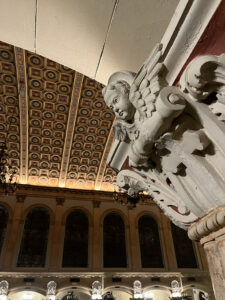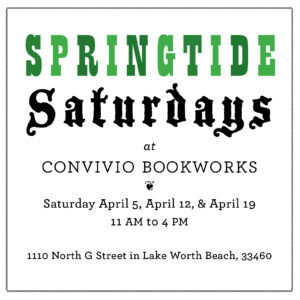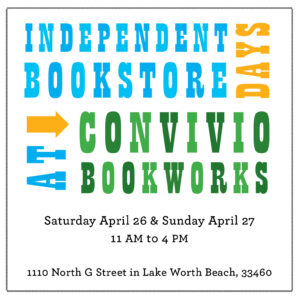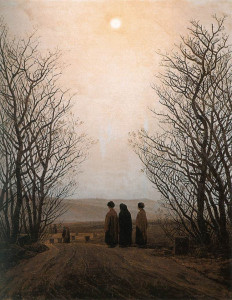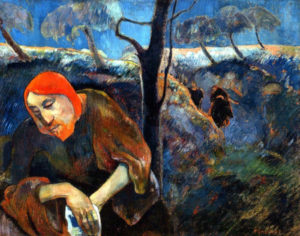
Saturday was a full day: I spent it pressure washing Mom’s patio––a full afternoon wet and soggy, hunched over a power nozzle, blasting mildew off of bricks. Every hour or so, I’d put down the nozzle, pour the murky water out of my shoes, and pick up the nozzle and start again. Toward nightfall, we ate, and after supper I could not keep my eyes open, so I went to a chaise lounge on the patio’s edge to rest my weary bones. I was sound asleep before I knew it. Just a short nap, a bit of refreshment while the coffee was brewing. I awoke just a few minutes later and before me in the night sky, beyond the pines and the clouds beyond them, was the waxing moon, bright and clear. And though over dinner we talked about baking for Easter, it didn’t really sink in until I saw that big moon. The moon’s presence before me was my portal, my concrete reminder of where we are in the round of the year: with its presence, we enter into Holy Week.
Indeed, Passover began with the setting sun on Saturday, just as I was dragging myself in from my day’s work. Passover and Holy Week are, I think, constant companions, for the Passover seder was the setting for Holy Thursday (or Maundy Thursday), which leads us to Good Friday and Easter Sunday. What I know about Passover is not much and mostly is in relation to my Catholic upbringing and to Passover’s connexion to the Easter story. I know that Passover commemorates the liberation of the Israelites from their slavery in Egypt, and I know what a friend told me once, which has always resonated with me about the holiday: “We are traveling through the desert with our ancestors via a table filled with metaphor and symbolism.” The meal is the seder, the same meal that Jesus celebrated with his disciples in the upper room on that Holy Thursday night before he died. Pesach is the Hebrew name for Passover, and, as words go, Pesach informs the name for Easter in many languages: in Italian, for instance, Easter is called Pasqua. In French, it is Pâques, in Portuguese, Páscoa, and in Spanish, Pascua. (The English word “Easter” does not share this etymological relation to Pesach. Our word for the holiday comes down from the Old English Eostre, related to the German Ostern and an Anglo-Saxon goddess whose feast day was celebrated around the Spring Equinox. But my apologies––I often find myself winding down weird linguistic roads.)
The Sunday that sets Holy Week in motion is Palm Sunday, or Passion Sunday. Father Brice at St. Paul’s used to say that “more people come to church when we give stuff away,” and it is one of those days when you do leave with a gift: the gift of palms, which some folks then take home and fashion into crosses. And while that part is nice, I’ve always felt a bit conflicted about Palm Sunday. I never understand what emotion I should be feeling, and it feels sometimes like the Cliff Notes version of Holy Week, condensed for busy people. And so I’ve never been terribly fond of the day.
It is Holy Thursday I love. It is one of the most beautiful nights of the year: a quiet and unassuming holiday/holyday, remarkable in its consistency, for the moon is always big and beautiful this night, hauntingly present, a constant companion as we make our pilgrimage in an old tradition that would have us visit three churches over the course of the evening. My grandmother, Assunta, taught me that custom, but, for some reason, not until the Holy Week after Grandpa had died. I think suddenly these old traditions meant more to her. I discovered then that the world is different at night. Churches glowing from within, moonlight reflecting on columns and limestone figures. Astonishingly quiet, serene stillness.
The actual Holy Thursday mass in most churches comes around sunset. It is the Mass of the Lord’s Supper, commemorating that Passover seder, the last supper so often depicted by artists. Jesus began by washing the feet of his disciples, a humble act accompanied by the suggestion that we, too, should not be above doing even the lowest things for others. At supper, he broke bread and passed the cup of wine: the central act of every Mass.
This year, like last, I won’t be going to any church gatherings for Holy Week and Easter. But typically, the Holy Thursday Mass I attend is a trilingual one, in English, Spanish, and Creole. It’s long and it’s crowded but I love it. It is the one Mass each year in our congregation where folks from so many diverse communities finally come together. For years I would seek out and sit next to an old Creole woman who reminded me of my grandmother, but I haven’t seen her for many years now, and I suspect she’s long gone now. And so I sit there with people I do not necessarily know and I think of my grandmother and the old Creole woman who had no idea she was so important to me.
The First Reading is in one language, the Second Reading in another, and the Gospel in the last of them. If you don’t know the language being spoken, you read along on your own. And as crowded as it is, still there are two choirs: one singing in English, the other in Creole, coming together, too, for this one night each year. The Creole songs are long and mysterious. One of them is sung to the tune of “My Old Kentucky Home.” They sing in Creole while I remember what I can from Stephen Foster’s song and each year they sing that song, I think of the small scrap of paper found in Stephen Foster’s pocket after he died. On it, he had scribbled five touching words: Dear friends and gentle hearts. That’s exactly how I feel each year on this night.
The Mass ends with the transfer of the Blessed Sacrament to the chapel while the congregation sings the Pange Lingua, acapella. Its more proper name is Pange Lingua Gloriosi Corporis Mysterium, an old hymn written in Latin by St. Thomas Aquinas in the 13th century. “Mysterium” is very appropriate, for this is a night wrapped in mystery and beauty, both of which truly begin once the Pange Lingua is done. There is no real end to the Mass. A small bit of chaos ensues as church workers begin to prepare for the Good Friday services the next day. People get up and leave, others mill about, and it’s noisy hustle and hubbub for a good 20 minutes until, eventually, the noise fades away as the church empties to just a few hardy souls who are there to sit. Some are in prayer, some are in reflection. Most, perhaps, are like me: doing some of all those things but also just being part of something bigger than ourselves, as it should be, in the company of others.
The tradition varies, apparently. The one that Grandma passed down to us is to visit three churches on this night. But I’ve heard of some people visiting seven churches. Both are magical numbers: 3 for the Trinity, of course, and for the three aspects of the Goddess (virgin, mother, crone), amongst other things, and 7 for more things than you might imagine: the seven sacraments, the seven days of creation, the seven sorrows of Mary, seven loaves and fishes… Still, three churches is plenty. Grandma may have been pious but she was not a martyr.
Our pilgrimage each year typically takes Seth and me from the trilingual Mass at St. Anne’s, the small old church surrounded by the tall buildings of Downtown West Palm Beach, across the lagoon to the much grander St. Edward’s in Palm Beach, which rivals the Vatican, then down the road to Bethesda by the Sea, where each year we wander the grounds, looking at the gargoyles and the crypts and the fountain, and we look for the boar in the stained glass window that shines onto the courtyard. We make these rounds each year on this night, sitting, kneeling, and me, I remember all those who have gone before us doing this very same thing. This is the value of ceremony and tradition to me: this connexion across time and space. And no matter where I go this night, the moon is there tagging along, trusted companion, never tiring, illuminating the night and the trees as much as the churches themselves illuminate their stained glass windows shining out from within. No one after lighting a lamp puts it under the bushel basket, but on the lamp stand, and it gives light to all in the house.
Image: “Christ on the Mount of Olives” by Paul Gauguin. Oil on canvas, 1889 [Public Domain via Wikimedia Commons].
SPRINGTIME STOCK-UP SALE continues for this week and maybe just a bit longer past Easter Sunday and Easter Monday at our website. Use discount code BUNNY at checkout for $10 off when you spend $65 on everything in the shop. Lots of beautiful handicrafts for Easter to welcome the season from Germany, Poland, and the Ukraine. Plus a deal for the locals with a lower minimum: use discount code LOCAL5 at checkout for $5 off $25 when you choose the pick up option and pick up at our front porch. Click here to shop!
